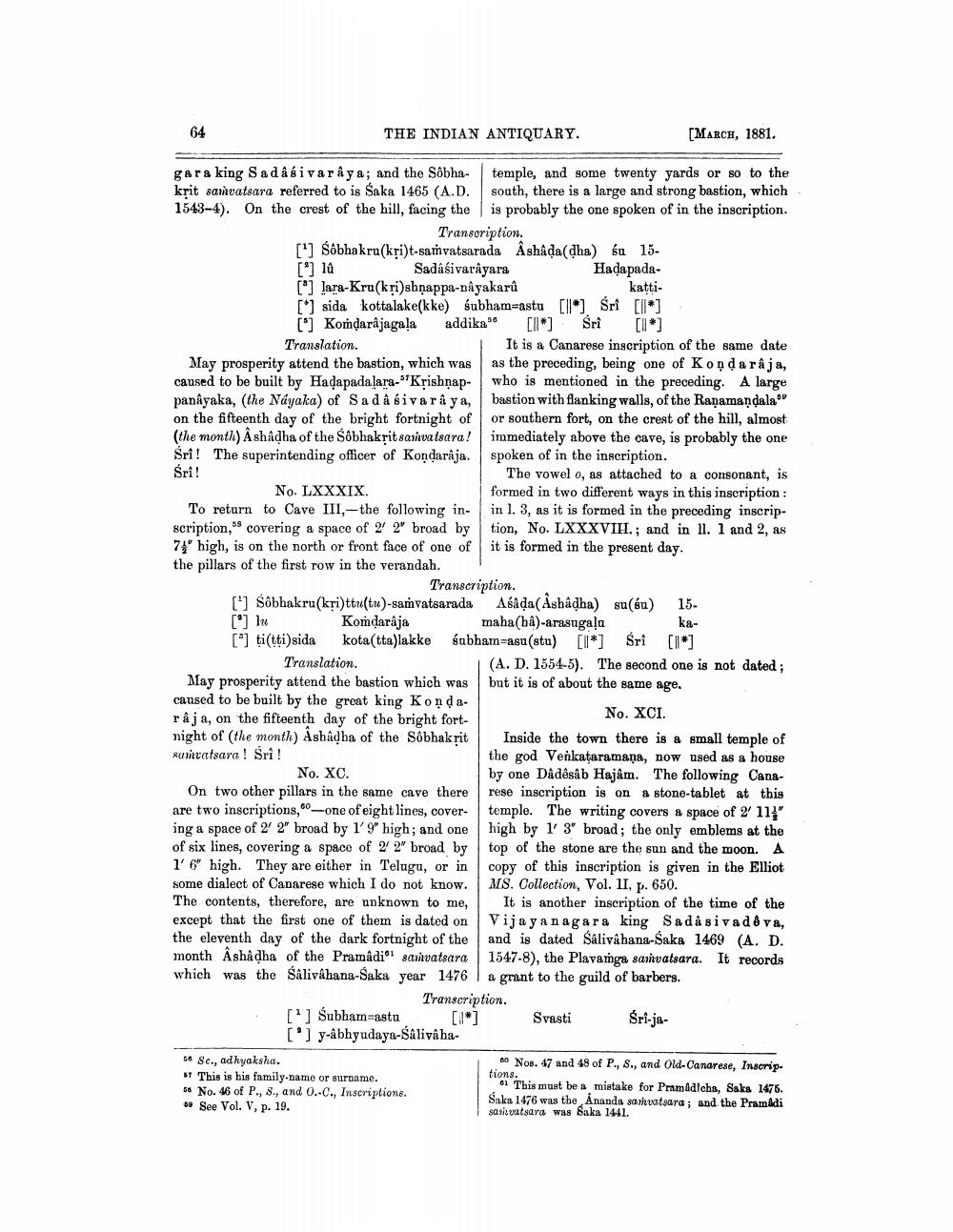________________
64
THE INDIAN ANTIQUARY.
[MARCH, 1881.
temple, and some twenty yards or so to the south, there is a large and strong bastion, which is probably the one spoken of in the inscription. Transcription.
Sadasivarayara
gara king Sadasivaraya; and the Sôbhakrit samvatsara referred to is Saka 1465 (A.D. 1543-4). On the crest of the hill, facing the
[*] Sibbakra(kri)t-samvatsarada Ashida(dha) a 15[*] lâ Haḍapada[*]lara-Kru(krishnappa-niyakaru katti[*] sida kottalake(kke) subham-astu [*] Śrî [*] [] Komḍarajagala Śrî [1] Translation.
addika
May prosperity attend the bastion, which was caused to be built by Haḍapadalara-"Krishnappanayaka, (the Nayaka) of Sadasivarâ ya, on the fifteenth day of the bright fortnight of (the month) Ashadha of the Sôbhakṛit samvatsara! Śri! The superintending officer of Kondarâja. Śri!
No. LXXXIX.
To return to Cave III,-the following inscription, covering a space of 2' 2" broad by 7 high, is on the north or front face of one of the pillars of the first row in the verandah.
Translation. May prosperity attend the bastion which was caused to be built by the great king Kondarâja, on the fifteenth day of the bright fortnight of (the month) Ashadha of the Sobhakṛit samvatsara! Śrî!
Transcription. [*] Śôbhakru(kṛi)ttu(tu)-samvatsarada Asâḍa (Âshâḍha) su(su) [*] lu Komdaraja maha (ha)-arasugala kota (tta)lakke subham-asu (stu) [*] Śri [*]
15ka
[] ti(tti)sida
No. XC.
On two other pillars in the same cave there are two inscriptions,60-one of eight lines, covering a space of 2' 2" broad by 1' 9" high; and one of six lines, covering a space of 2' 2" broad by 1' 6" high. They are either in Telugu, or in some dialect of Canarese which I do not know. The contents, therefore, are unknown to me, except that the first one of them is dated on the eleventh day of the dark fortnight of the month Ashåḍha of the Pramâdi samvatsara which was the Sâlivâhana-Saka year 1476
se Sc., adhyaksha.
57 This is his family-name or surname.
58 No. 46 of P., S., and O.-C., Inscriptione. se See Vol. V, p. 19.
ניוו]
[1] Subham=astu [*] [*]y-bhyudays-Saliraha
It is a Canarese inscription of the same date as the preceding, being one of Kondarâja, who is mentioned in the preceding. A large bastion with flanking walls, of the Ranamandala or southern fort, on the crest of the hill, almost immediately above the cave, is probably the one spoken of in the inscription.
The vowel o, as attached to a consonant, is formed in two different ways in this inscription: in 1. 3, as it is formed in the preceding inscription, No. LXXXVII.; and in 11. 1 and 2, as it is formed in the present day.
No. XCI.
Inside the town there is a small temple of the god Venkataramana, now used as a house by one Dâdêsâb Hajâm. The following Canarese inscription is on a stone-tablet at this temple. The writing covers a space of 2' 11" high by 1' 3" broad; the only emblems at the top of the stone are the sun and the moon. A copy of this inscription is given in the Elliot MS. Collection, Vol. II, p. 650.
It is another inscription of the time of the Vijayanagara king Sadasivadova, and is dated Sâlivâhana-Saka 1469 (A. D. 1547-8), the Plavamga samvatsara. It records a grant to the guild of barbers. Transcription.
Sel-ja
(A. D. 1554-5). The second one is not dated; but it is of about the same age.
Svasti
60 Nos. 47 and 48 of P., S., and Old-Canarese, Inscriptions.
61 This must be a mistake for Pramâdicha, Saka 1475. Saka 1476 was the Ananda samvatsara; and the Pramadi samvatsara was Saka 1441.




